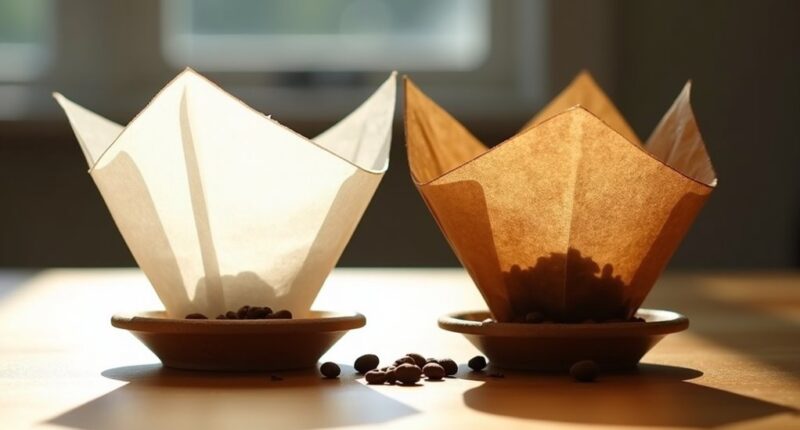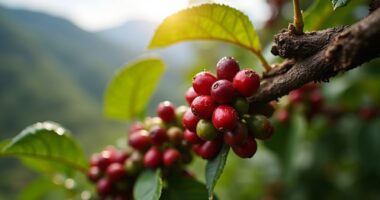White and brown coffee filters aren’t just pretty accessories for your brew. Brown ones are unbleached and eco-friendly, while white filters are bleached for that crisp, clean look. If you scrunch them up and take a whiff, you might catch that paper smell with brown filters, but rinsing them helps! Plus, brown filters compost better, which is a win for Mother Earth. Stick around, and you’ll discover which filter might just be your perfect coffee partner!
At a Glance
- Brown filters are unbleached, retaining natural qualities, while white filters undergo a bleach bath for a cleaner appearance.
- Brown filters avoid harmful chemicals and decompose faster, making them suitable for composting.
- White filters may offer better clarity and aroma in coffee, though taste differences are often minimal.
- Rinsing brown filters can help eliminate any papery flavors before brewing.
- Both filter types can affect coffee storage, but brewing techniques have a more significant impact on flavor.
Manufacturing Process of Coffee Filters
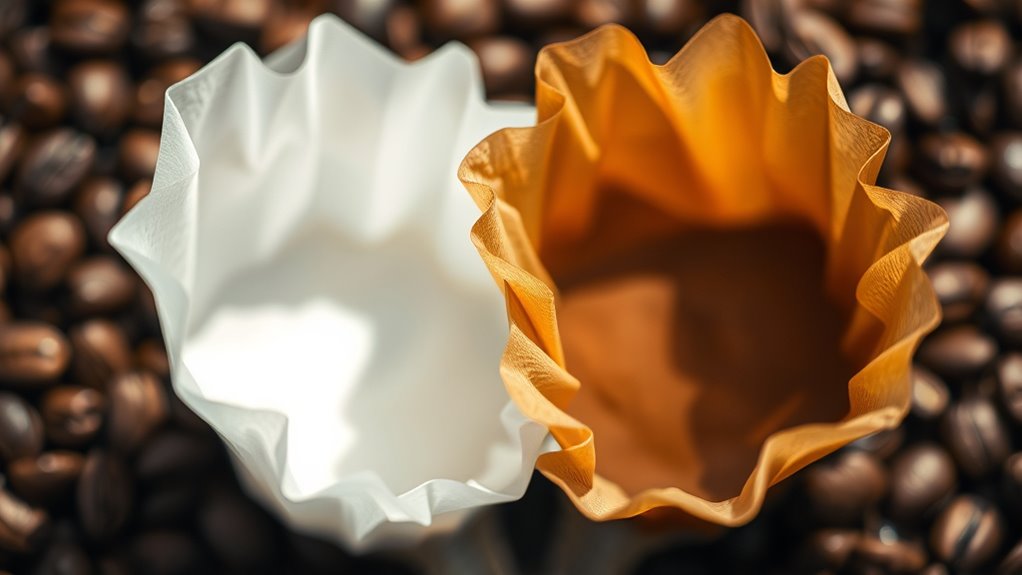
When you think about your morning coffee, you probably don’t consider what goes into those filters, right?
Have you ever paused to think about the journey of your coffee filters?
Well, let’s explore! The manufacturing process blends cool filter technology with impressive production efficiency. They start with wood chips, turning them into fibers through pulping.
Brown filters keep it natural, while white ones get a bleach bath. Once that’s done, machines whip up a slurry, spread it, and dry it into sheets faster than you can say “coffee break!”
Then, they cut and shape those sheets into filters, all while recycling scraps. It’s like a coffee filter party behind the scenes!
Interestingly, many eco-conscious consumers are opting for eco-friendly coffee makers that use these filters to reduce their environmental impact.
Environmental Considerations of Filter Choices
You’ve got your coffee filters sorted, but have you ever contemplated how your choice impacts the planet?
Making mindful decisions about your filters connects you to sustainability practices and helps reduce your ecological footprint. Here’s what to reflect on:
- Brown filters are unbleached, so they skip harmful chemicals.
- White filters can release toxins into water and soil if not disposed of properly.
- Oxygen-bleached filters are better but still need energy to produce.
- Unbleached filters decompose faster, making them compost-friendly.
- Reusable filters cut down paper waste completely!
Additionally, choosing eco-friendly coffee options can further minimize your environmental impact.
Taste and Quality Comparison
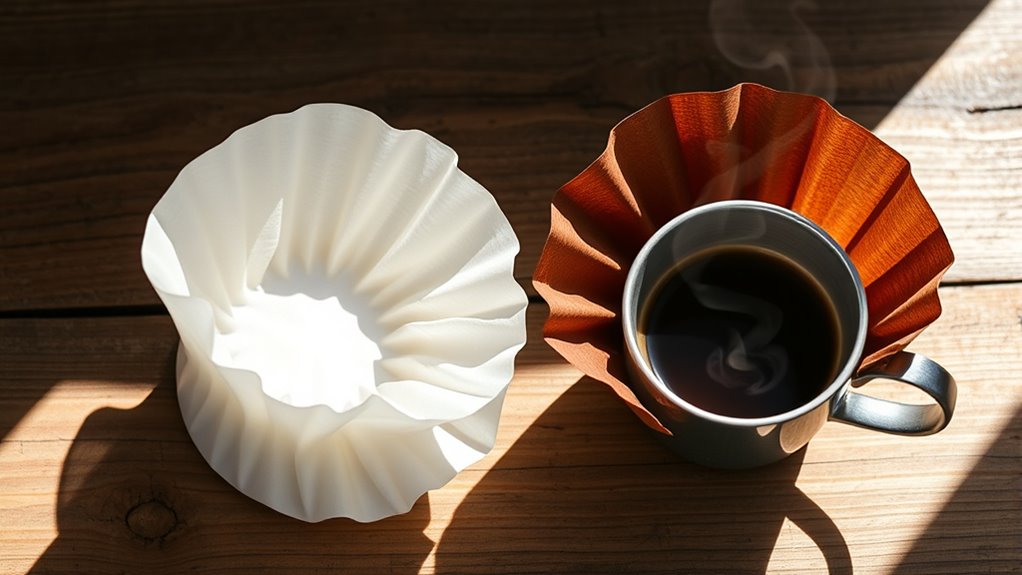
Let’s plunge into the world of coffee filters, shall we?
When it comes to flavor profiles, both brown and white filters can brew a delicious cup—if you prep them right! Rinsing brown filters can zap away any papery taste, while white filters often deliver slightly better clarity and aroma. Additionally, the choice of filter can influence the overall coffee storage container you might want to use for maintaining freshness. But don’t fret! Many coffee lovers don’t notice a big difference. Your brewing techniques matter more than the filter’s color.
Usage and Maintenance Tips
While you might think coffee filters are just paper, using and maintaining them can make a big difference in your brewing game!
Here are some quick tips to keep your filters in top shape:
- Always pre-rinse your filters to avoid that papery taste.
- Store filters in a dry, cool place to prevent mold.
- Keep an eye on humidity to avoid sticking.
- Dispose of used filters promptly to keep things fresh.
- Compost brown filters for an eco-friendly boost!
- Consider using high-quality materials for your filters, as they can enhance the flavor of your brew.
These small steps help you brew better coffee and feel good about your choices.
Happy brewing, friends!
Market Availability and Cost Differences
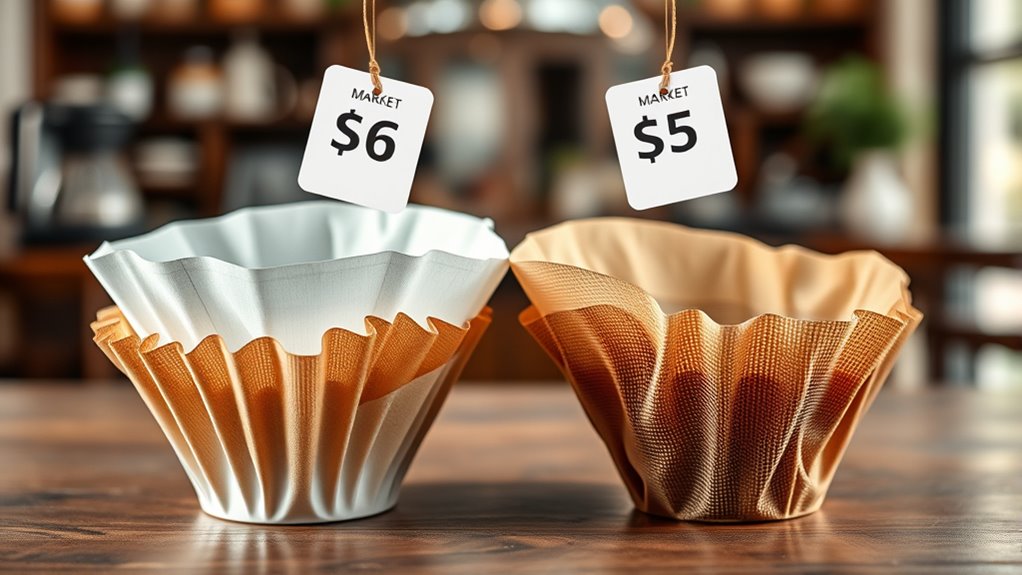
When you’re on the hunt for coffee filters, it’s good to know that both white and brown options are pretty easy to find these days.
You’ll spot popular filter brands like Hario, Melitta, and Chemex lining the shelves. The price difference isn’t huge—brown filters often cost less since they skip the bleaching process.
But let’s be real, most of us aren’t breaking the bank over a few cents! Whether you’re going for eco-friendly vibes or a cleaner look, you’ve got choices. Additionally, many coffee enthusiasts are exploring non-dairy creamers to enhance their brews without dairy.
Alternative Coffee Filter Options
Coffee filters aren’t just a one-size-fits-all situation, you know!
If you’re looking to mix things up, here are some fun alternatives:
- Cloth filters: Reusable, eco-friendly, and great for richer taste profiles.
- Metal filters: Durable and reusable, but watch out for some sediment.
- Bamboo filters: Biodegradable and sturdy, perfect for guilt-free brewing.
- Silver filters: Antibacterial and funky, but effectiveness can vary.
- Ceramic and activated carbon filters: Specialty choices for unique flavor experiences.
Choosing the right filter can totally change your coffee game, so experiment and find your favorite! Additionally, using a coffee maker with grinder can enhance the freshness of your brew, making your coffee experience even better.
Enjoy that caffeine adventure!
Impact of Consumer Preferences
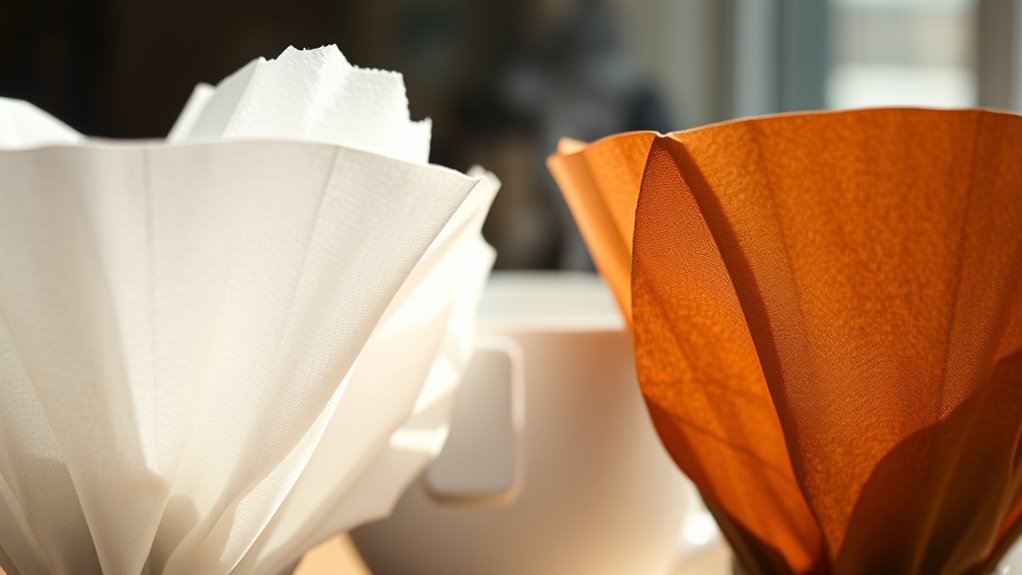
You might be surprised at how much your coffee filter choice can say about you!
If you love that clean, crisp look, you might lean toward white filters, drawn by their aesthetic appeal.
But if you’re eco-conscious, brown filters might catch your eye, thanks to those eco-friendly trends.
Health concerns also play a role; some folks worry about chemicals in bleached filters.
Plus, if you’re a black coffee lover, you might even notice a difference in taste! Additionally, some people prefer to pair their coffee with the perfect sweetener, enhancing their overall experience.
Innovation Trends in Coffee Filters
As the world of coffee continues to brew up some exciting innovations, it’s hard not to get a little giddy about what’s happening with coffee filters!
With new material advancements and filter technologies, you’ll find some really cool options out there:
- Eco-friendly, biodegradable filters
- High-performance papers that reduce paper taste
- App-controlled brewing systems
- Multi-layer filters for better extraction
- Subscription services for easy access
These trends not only keep our coffee tastier but also help the planet. Additionally, many of these innovations focus on using high-performance materials that enhance the brewing experience while being environmentally responsible.
